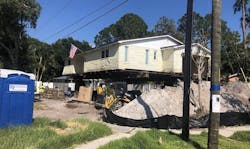House Lift: Elevating Foundations as a Response to Flooding
Several U.S. markets have responded to chronic flooding by mandating that buildings be elevated—sometimes significantly—above flood plains. That solution isn’t cheap, but it’s less expensive than rebuilding a flooded house.
AJS Building, Moving & Leveling, in Spring Hill, Fla., does two to five house lifts per year, according to co-owner Mike Knapp. Each takes about five to eight months, on average, to execute. Knapp is reluctant to discuss costs because, he says, each house is different. But where it may cost between $250 and $300 per square foot to rebuild a badly damaged house, “I can get people back into their homes for between $85 and $150 per square foot, and a lot quicker,” he points out.
Florida Design Firm Recommends Lifting Homes to Avoid Flood Damage
ArcDesign, a design firm in Clearwater, Fla., has provided drawings for AJS for a decade. Arc recently sent out postcards to 10,000 Florida homeowners recommending that they raise their homes preemptively. The firm’s president and CEO, Randy Young, explains that many homes in Florida are older and therefore aren’t compliant with newer building codes. If a major storm caused flood damage to a home and the repairs exceeded 50% of the home’s value, that house would need to be torn down and rebuilt to receive FEMA money. “It’s just better to elevate those houses now and save time and expense,” Young says.
Scott Frankel, co-president and principal of Frankel Building Group, in Houston, says raising a 1,500-square-foot home on slab with a veranda in his market costs between $35,000 and $40,000. But if the redesign calls for only the crawlspace to be raised, using interior piers, the cost drops to between $10,000 and $15,000. “It depends on the part of town and the way the water flows,” he says.
Read more about resilient construction and home builders' efforts to build more resilient homes:
- The Need for Resilient Construction
- Rebuilding After Disaster: A Painstaking Process
- How One Prefab Building Company Is Rebuilding Better in the Face of Disaster
- Roadblocks to Resilient Construction After a Natural Disaster
- Disaster Recovery Through Job Order Contracting



